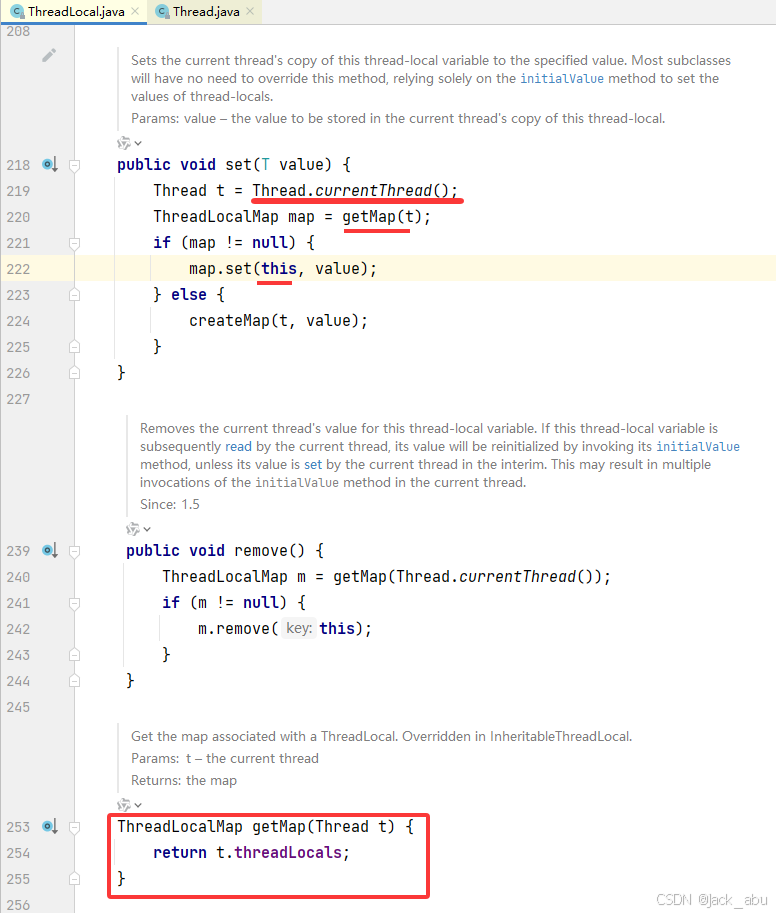一、Thread、ThreadLocal与ThreadLocalMap的关系解析
1. 核心关系架构
-
Thread与ThreadLocalMap
每个Thread实例内部维护一个ThreadLocalMap对象(名为threadLocals),用于存储该线程的本地变量副本。这是线程隔离的核心载体,每个线程的ThreadLocalMap完全独立,避免多线程竞争。public class Thread implements Runnable { ... /* ThreadLocal values pertaining to this thread. This map is maintained * by the ThreadLocal class. */ ThreadLocal.ThreadLocalMap threadLocals = null; /* * InheritableThreadLocal values pertaining to this thread. This map is * maintained by the InheritableThreadLocal class. */ ThreadLocal.ThreadLocalMap inheritableThreadLocals = null; ... } -
ThreadLocal与ThreadLocalMap
ThreadLocal是操作ThreadLocalMap的工具类,其set()、get()方法通过当前线程的ThreadLocalMap存取数据。ThreadLocal本身不存储数据,而是作为键(弱引用)关联值。例如:ThreadLocal<String> local = new ThreadLocal<>(); local.set("Thread-1 Value"); // 数据存入当前线程的ThreadLocalMap
-
ThreadLocalMap结构
ThreadLocalMap是ThreadLocal的静态内部类,采用哈希表结构,以ThreadLocal实例为键、线程变量值为值。其内部使用Entry数组存储,键为弱引用(WeakReference),避免强引用导致内存泄漏。冲突处理采用线性探测法,通过ThreadLocal.hashCode()计算存储位置。static class ThreadLocalMap { /** * The entries in this hash map extend WeakReference, using * its main ref field as the key (which is always a * ThreadLocal object). Note that null keys (i.e. entry.get() * == null) mean that the key is no longer referenced, so the * entry can be expunged from table. Such entries are referred to * as "stale entries" in the code that follows. */ static class Entry extends WeakReference<ThreadLocal<?>> { /** The value associated with this ThreadLocal. */ Object value; Entry(ThreadLocal<?> k, Object v) { super(k); value = v; } } ... /** * Get the entry associated with key. This method * itself handles only the fast path: a direct hit of existing * key. It otherwise relays to getEntryAfterMiss. This is * designed to maximize performance for direct hits, in part * by making this method readily inlinable. * * @param key the thread local object * @return the entry associated with key, or null if no such */ private Entry getEntry(ThreadLocal<?> key) { int i = key.threadLocalHashCode & (table.length - 1); Entry e = table[i]; if (e != null && e.refersTo(key)) return e; else return getEntryAfterMiss(key, i, e); } /** * Version of getEntry method for use when key is not found in * its direct hash slot. * * @param key the thread local object * @param i the table index for key's hash code * @param e the entry at table[i] * @return the entry associated with key, or null if no such */ private Entry getEntryAfterMiss(ThreadLocal<?> key, int i, Entry e) { Entry[] tab = table; int len = tab.length; while (e != null) { if (e.refersTo(key)) return e; if (e.refersTo(null)) expungeStaleEntry(i); else i = nextIndex(i, len); e = tab[i]; } return null; } /** * Set the value associated with key. * * @param key the thread local object * @param value the value to be set */ private void set(ThreadLocal<?> key, Object value) { // We don't use a fast path as with get() because it is at // least as common to use set() to create new entries as // it is to replace existing ones, in which case, a fast // path would fail more often than not. Entry[] tab = table; int len = tab.length; int i = key.threadLocalHashCode & (len-1); for (Entry e = tab[i]; e != null; e = tab[i = nextIndex(i, len)]) { if (e.refersTo(key)) { e.value = value; return; } if (e.refersTo(null)) { replaceStaleEntry(key, value, i); return; } } tab[i] = new Entry(key, value); int sz = ++size; if (!cleanSomeSlots(i, sz) && sz >= threshold) rehash(); } /** * Remove the entry for key. */ private void remove(ThreadLocal<?> key) { Entry[] tab = table; int len = tab.length; int i = key.threadLocalHashCode & (len-1); for (Entry e = tab[i]; e != null; e = tab[i = nextIndex(i, len)]) { if (e.refersTo(key)) { e.clear(); expungeStaleEntry(i); return; } } } ... }
2. ThreadLocal如何保障线程安全
-
线程隔离机制
每个线程通过自己的ThreadLocalMap访问独立变量副本,如线程A和线程B操作同一ThreadLocal变量时,实际访问的是各自ThreadLocalMap中的不同Entry,天然避免共享和竞争,无需同步锁。 -
数据操作流程
set():获取当前线程的ThreadLocalMap,以当前ThreadLocal为键存储值。get():从当前线程的ThreadLocalMap中以ThreadLocal为键检索值。remove():显式移除Entry,防止内存泄漏。
3. 内存管理与泄漏风险
-
弱引用键设计
ThreadLocalMap的键使用弱引用,当外部无强引用指向ThreadLocal时,键可被垃圾回收,但残留Entry仍需手动清理。若未调用remove(),线程池中复用线程可能导致旧值残留(脏数据)。 -
解决方案
- 及时调用
remove()清理当前线程的ThreadLocalMap。 - 避免在
ThreadLocal中存储大对象,减少内存占用。 - 使用静态内部类(如
InheritableThreadLocal)时需谨慎,防止跨线程数据泄露。
- 及时调用
4. 应用场景与示例
- 典型场景
- 数据库连接管理:Hibernate/Spring事务中,为每个线程分配独立连接。
- 用户会话跟踪:Web请求中传递用户ID、请求ID等上下文信息。
- 线程安全工具:如
SimpleDateFormat的线程安全封装。
- 代码示例
// 线程安全存储用户ID public class UserContext { private static final ThreadLocal<String> userThreadLocal = new ThreadLocal<>(); public static void setUserId(String userId) { userThreadLocal.set(userId); } public static String getUserId() { return userThreadLocal.get(); } public static void clear() { userThreadLocal.remove(); } }
5. 对比与扩展
-
与同步锁的差异
ThreadLocal以空间(每个线程独立副本)换时间(无锁操作),适用于高并发场景;而同步锁通过竞争-等待机制保障共享变量安全,但存在性能损耗。 -
与InheritableThreadLocal
子类可继承父线程的ThreadLocal值,但需注意线程池中子线程复用可能导致数据污染,需配合remove()使用。
总结:Thread通过内置的ThreadLocalMap实现线程隔离,ThreadLocal作为操作入口,通过弱引用键和显式清理机制平衡线程安全与内存管理,是Java多线程编程中实现无共享变量的高效方案。
二、ThreadLocalMap.Entry的弱引用设计
ThreadLocalMap 的 Entry 使用 WeakReference<ThreadLocal<?>> 作为键的弱引用设计,是为了解决 内存泄漏 问题,同时平衡功能需求与资源管理。
1. 核心问题:ThreadLocal 的内存泄漏风险
-
场景描述
当ThreadLocal实例不再被外部强引用(如局部变量、静态变量等)持有时,若ThreadLocalMap的键仍强引用它,会导致该ThreadLocal无法被垃圾回收(GC),进而其关联的Entry(存储的值)也无法释放,即使线程已结束,这些对象仍会滞留在内存中,造成内存泄漏。 -
示例代码
public class MemoryLeakDemo { public static void main(String[] args) { ThreadLocal<String> local = new ThreadLocal<>(); local.set("Leak Test"); // 存入当前线程的ThreadLocalMap local = null; // 外部强引用置空 // 若Entry键为强引用,此时local无法被GC,Entry和值"Leak Test"会一直存在 } }
2. 弱引用的解决方案
-
WeakReference 的作用
WeakReference<ThreadLocal<?>>允许ThreadLocal实例在 仅被弱引用持有 时被 GC 回收。当外部无强引用指向ThreadLocal时,JVM 会在下次 GC 时回收它,此时ThreadLocalMap中对应的键会变为null,但值仍保留在Entry中。 -
Entry 的结构
static class Entry extends WeakReference<ThreadLocal<?>> { Object value; // 实际存储的值 Entry(ThreadLocal<?> k, Object v) { super(k); // 键为弱引用 value = v; } }
3. 弱引用的好处
(1) 防止键的内存泄漏
-
自动回收无效键
当ThreadLocal实例不再被使用时(如局部变量离开作用域),弱引用键允许 GC 回收它,避免ThreadLocalMap中积累大量无效键(key=null的Entry)。 -
对比强引用
若使用强引用键,即使ThreadLocal实例已无用,Entry仍会保留在ThreadLocalMap中,直到线程结束或手动调用remove(),这在长生命周期线程(如线程池)中会导致严重泄漏。
(2) 保留值以备后续清理
-
延迟清理值
键被 GC 后,Entry的键变为null,但值仍存在。此时ThreadLocalMap会在后续操作(如get()、set()、rehash())中检测到key=null的Entry,并主动清理这些无效条目,释放值占用的内存。 -
清理机制示例
private void expungeStaleEntry(int staleSlot) { Entry e = table[staleSlot]; if (e != null && e.get() == null) { // 键已被GC table[staleSlot] = null; // 清除Entry // 后续可能触发其他清理逻辑... } }
(3) 平衡功能与资源管理
-
无需显式清理所有情况
弱引用键减少了开发者必须手动调用remove()的场景,但 仍建议显式清理(尤其在长生命周期线程中),因为值可能占用大量内存(如数据库连接),而弱引用仅解决键的泄漏问题。 -
与强引用值的权衡
值使用强引用是因为业务逻辑通常需要主动管理其生命周期(如关闭连接),而键的弱引用设计则是对“自动回收无用键”的优化。
4. 潜在问题与注意事项
(1) 残留值导致的内存泄漏
-
问题
即使键被 GC,若值未被清理且线程持续运行,值仍会占用内存。例如:ThreadLocal<LargeObject> local = new ThreadLocal<>(); local.set(new LargeObject()); // 存储大对象 local = null; // 键被GC,但值仍存在 // 若未调用remove(),LargeObject会一直滞留 -
解决方案
- 调用
ThreadLocal.remove()显式清理。 - 在
try-finally块中清理:try { local.set(value); // 使用value... } finally { local.remove(); }
- 调用
(2) 线程池中的复用问题
-
场景
线程池中的线程被复用时,若未清理ThreadLocalMap,前一次任务设置的ThreadLocal值可能被后续任务误读(脏数据)。 -
解决方案
- 使用
try-finally或 AOP 拦截器自动清理。 - 考虑
InheritableThreadLocal的替代方案(需谨慎使用)。
- 使用
5. 总结:弱引用的设计意图
| 设计目的 | 实现方式 | 优势 |
|---|---|---|
| 防止键的内存泄漏 | 键使用 WeakReference<ThreadLocal<?>> | 允许 GC 回收无用 ThreadLocal,避免 ThreadLocalMap 积累无效键。 |
| 延迟清理值 | 后续操作中检测并清理 key=null 的 Entry | 减少立即清理的开销,平衡性能与内存管理。 |
| 降低开发者清理负担 | 部分场景自动回收键 | 无需手动清理所有 ThreadLocal,但关键场景仍需显式调用 remove()。 |
最佳实践:
- 优先使用
try-finally或try-with-resources确保ThreadLocal.remove()被调用。 - 避免在
ThreadLocal中存储大对象或需显式关闭的资源(如数据库连接、文件句柄)。 - 线程池场景下,结合工具类(如 Spring 的
ThreadLocalAwareThreadLocal)或 AOP 自动清理。
























 10万+
10万+

 被折叠的 条评论
为什么被折叠?
被折叠的 条评论
为什么被折叠?










